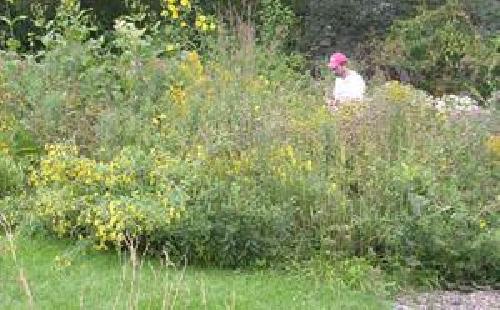Prairie gardens offer Midwestern suburban dwellers an alternative option to the traditional grass lawn. Their combination of native grasses, like tall and wispy bluestem and sideoats, and forbs, such as the colorful yellow and purple coneflowers, are a welcome addition to any lawn.
They also attract beneficial bees and other insects, as well as beautiful butterflies. The prairie plants are native to the Midwest and once established can require fewer resources, such as water, fertilizer, and time to maintain.
Besides just the gardens looking pleasing to the eye, Johnston was interested in the ability of prairie gardens to benefit the soil underneath them. Urbanization is known to degrade the quality of soil. The process usually requires stripping the topsoil away to make room for building foundations. This, coupled with increased traffic from heavy machinery, can lead to soil compaction.
Compaction damages the soil in numerous ways. It decreases the available spaces between soil particles, making it difficult for oxygen and water to travel through the soil. It also makes it harder for plant roots to penetrate deep into the soil.

"The aesthetic is all part of the package," says Marie Johnston of the University of Wisconsin-Madison Department of Soil Science. "By planting native species, people find some intrinsic value in giving back to the environment. By studying soils around Madison, Wisconsin, we've found that the results are consistent with soils that have suffered from compaction. They've been altered in such a way that the airspace within them has been diminished."
To see if prairie gardens help alleviate soil compaction, Johnston and her colleagues located 12 residential prairie gardens in the Madison area. They then compared the soil under the prairie garden to the soil under the adjacent lawn to see if there were any differences.
The researchers looked at four different soil characteristics: soil density, the resistance of soil to root penetration, the presence of decomposed organic materials, and how easily water moves through.
"If the soil's pores aren't large enough or aren't connected well, water will have a hard time flowing through the soil," Johnston says. "This is often the case in compacted soils."
Their study however, yielded mixed results. They did find a general trend in the top 0.15 meters of all the prairie gardens towards lower soil density, better root penetration, more organic matter, and greater water movement. However, these differences weren't enough to conclude that the prairie gardens were responsible for the changes in the soil. The soil on adjacent lawns had similar properties, and the soil at all sites showed signs of previous compaction.
"While our data don't support that prairie gardens are flat out better for soil than lawns, the four properties all moved in a consistent direction and were all in agreement and good for the soil," explains Johnston. "So then you step back from that as a scientist and ask, is that a meaningful change? In same cases this change could be functionally important and should be explored in more research."
The researchers thought that since prairie roots go much deeper than those in a traditional lawn, they could help the soil be less compacted. They also thought that the greater biomass of prairie plants would lead to more soil organic matter. Johnston says it's possible that the soil is so badly compacted that not even prairie roots are able to penetrate it or that the prairie plants just need more time to have a real beneficial effect.
"We can still conclude that prairie gardens are a viable option for gardeners who wish to benefit their soil, but how and when these changes occur requires more testing," she says. "I got into this work because I am fascinated by how plants can help both the air and the soil, and I think the next step is a more controlled study that might clarify how these types of prairie plantings improve the soil."




Comments